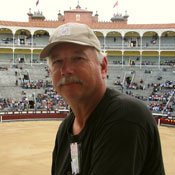The view from the ridgeline above the former ski resort was extraordinary, although the hangman's noose on the scaffold just in front of me somewhat marred the image. The valley was steep and heavily wooded, and the mountain on other side of the valley rose up and seemed close enough to touch. The trees looked blue through some optical illusion of the sun and air. It was cool that day in the Vosges Mountains and crisp, and I congratulated myself on bringing a jacket even though it had been quite warm in the Rhine Valley.
Denver, my 12-year-old, was cavorting around in sandals and seemed oblivious to the cold and to the ghosts all around us. I had made it through about half the museum before it started to make me sick, and I had to leave. Denver's mother was still inside. As a medical professional, she found the descriptions of the experiments practiced on the prisoners horrifying but also morbidly interesting.
We were visiting the former Nazi Concentration Camp located near Natzweiler, in the Alsace region, the only concentration camp that had been located in France. There isn't much left of it, but the French have turned it into a memorial, and many people were visiting on this beautiful Sunday afternoon.
As I waited for my wife and contemplated the seemingly unending horrors that man can perpetrate on other men, I realized that standing here answered the question that I had asked myself just a couple of weeks before. Then, I had been standing on a bluff overlooking the D-Day beaches and wondering why in the world it had been necessary.
Specifically, I had stood where WN 62 had been located. WN is short for Widerstandsnest in German and can be roughly translated to "Resistance Nest." WN 62 was a German strong point overlooking the Easy Red sector of Omaha Beach and was infamous for causing many American casualties during the D-Day landings.
As a former soldier myself, I have some experience with military weaponry. As I looked out from WN 62's position onto the beach where children played in the surf, it was clearly obvious that any soldier with just a modicum of training could wreak havoc on anyone trying to get ashore.
I remember asking myself at the time why it had been necessary to expose those soldiers to that murderous fire of these heavily defended beaches. It really was too much to ask them to wade through hundreds of yards of open water and beach under constant fire of defenders encased in concrete. It is incredible that we could ask anyone to do that and more incredible that they did.
The answer, of course, to why is right here, at Natzweiler. It is on the memorial to the 86 Jews who were gassed so a university professor could have a collection of Jewish skeletons. It's in the drawings of the brutality the prisoners endured and the horrors of everyday life survivors described.
It's why the concentration camp is still here and why the president of France paid a recent visit to the camp alongside the president of the Council of Europe and the president of the European Parliament. It is why WN 62 is preserved, why endless numbers of French schoolchildren were visiting the D-Day beaches while I was there, and why on June 6 we should stop and remember the sacrifices made to bring such madmen to justice and do our damndest to make sure it doesn't happen again.
Richard Coupe is a long-time resident of Mississippi and occasional contributor to the Jackson Free Press. He is currently a Fulbright Research Scholar at the University of Strasbourg and lives in Strasbourg, France, with his wife, Anne, and their youngest daughter, Denver.



Comments
Use the comment form below to begin a discussion about this content.
comments powered by Disqus